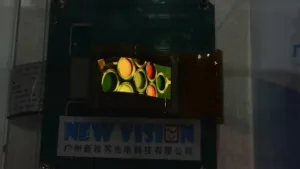The Innovation Zone (I-Zone) at SID Display Week 2017 in Los Angeles had approximately 50 exhibitors, more than double the average of years past. Was 2017 an unusually innovative year? Perhaps, but not on the evidence of the I-Zone. The exhibitor ranks were padded with a few shipping products (which are not permitted under I-Zone rules) and a large number of student research projects that did not embody significant innovations. (There should be a place at SID for solid student work that doesn’t reach the level of exceptional innovation, and there is. But it’s not the I-Zone.)
One student presentation that clearly did reach that level was the high-resolution automobile headlamp with 30,000-pixel LCD shutter shown by the University of Stuttgart and automotive lighting company Hella. A paper describing the work won the Distinguished Student Paper Award. The light pattern of the headlamp can be controlled with great flexibility and without moving parts, and can be integrated with the car’s GPS and situational awareness systems. The students, under the supervision of Norbert Fruehauf, designed the LCD for the headlamp. Merck contributed a special wide-temperature liquid-crystal formulation. The entire system, designed by Hella, is being tested in a Porsche Panamera and will be will be incorporated in the car beginning with the 2020 model year. A University of Stuttgart rep who has driven the test car said the user feels like the high beams are on all the time. The system seamlessly reduces face-level illumination when it detects an oncoming car.
A New Approach to Display-based Audio
Another genuine innovation, although it has been around for a couple of years. was presented by the gaming headphone maker, Turtle Bay. Their Hypersound transparent flat-panel loud speakers work on a different principle than the old NXT speakers, whose technology has been adapted by LG and Sony in their current high-end OLED-TVs. Turtle Bay’s speaker are capacitive, and the vibrating layer is driven at 100kHz and at 100kHz plus the audible side-band signal. The result, as explained by Turtle Bay’s rep, is that the audio portion of the signal is constructed in the space in front of the speakers. The effect is startling, with two speakers able to construct a surround-sound field of remarkable clarity and with sounds that are precisely located. Another characteristic is that the sound field is highly directional and can not be heard even ten degrees or so off axis. Turtle Beach is currently field testing the technology in kiosks, and is looking for manufacturing and application partners.
 Guardian/Synaptics has a new transparent touch film. Image:Ken Werner
Guardian/Synaptics has a new transparent touch film. Image:Ken Werner
Glassmaker, Guardian Industries, and touch specialist, Synaptics, were showing off their new transparent touch film, which consists of sputtered silver and a dielectric for index matching. Synaptics did the touch-control software and electronics. Guardian did the coating. The advantages are that the sensor consists of a single layer and it has high transmissivity, a Guardian rep said. The technology is being field-tested now and should be ready for customers in six to nine months, said the rep.
Display Logic was showing its new Liqui-Bond concept, which puts liquid between the cover glass and the display to reduce internal reflections instead of bonding it with optically clear adhesive. “The main advantage of Liqui-Bond over other bonding techniques is than since it is not actually laminated, it cannot delaminate.” It is also not actually, ya know, bonded.
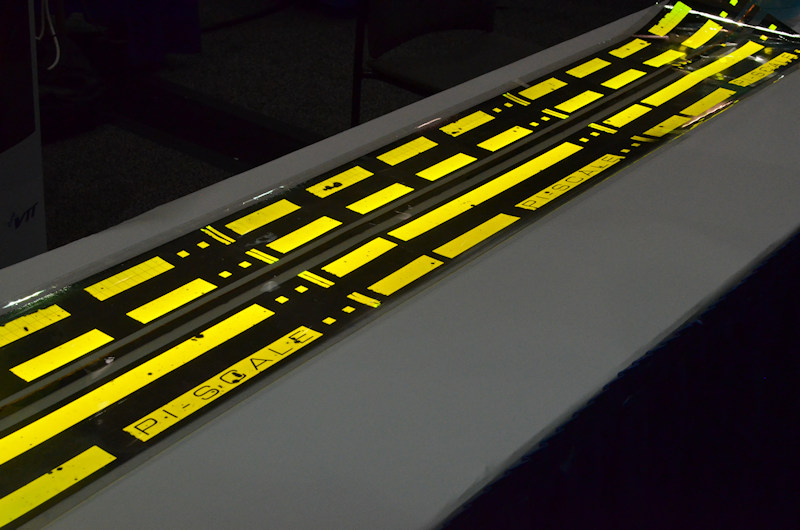 Pi Scale had this OLED lamp strip. Image: Ken Werner
Pi Scale had this OLED lamp strip. Image: Ken Werner
Pi-Scale described its open-access flexible OLED pilot line for lighting applications, and showed what it can produce: a long flexible film patterned with OLED lights. I guess Pi-Scale is looking for customers since a poster in the booth said “Explore your exciting design options with flexible OLEDs at www.PI-SCALE.eu.
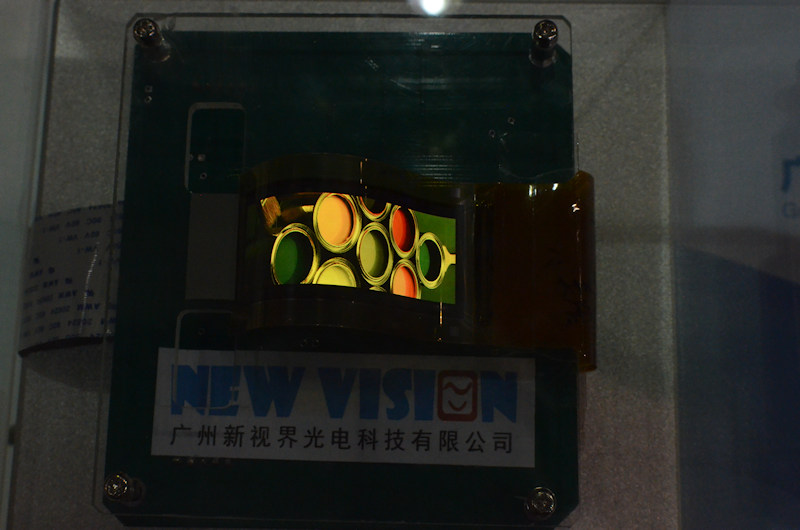 New Vision had flexible OLEDs Image:Ken Werner
New Vision had flexible OLEDs Image:Ken Werner
Ghuangzhou New Vision Opto-Eelectronic Technology Company was flexing its OLEDs, these for display applications.
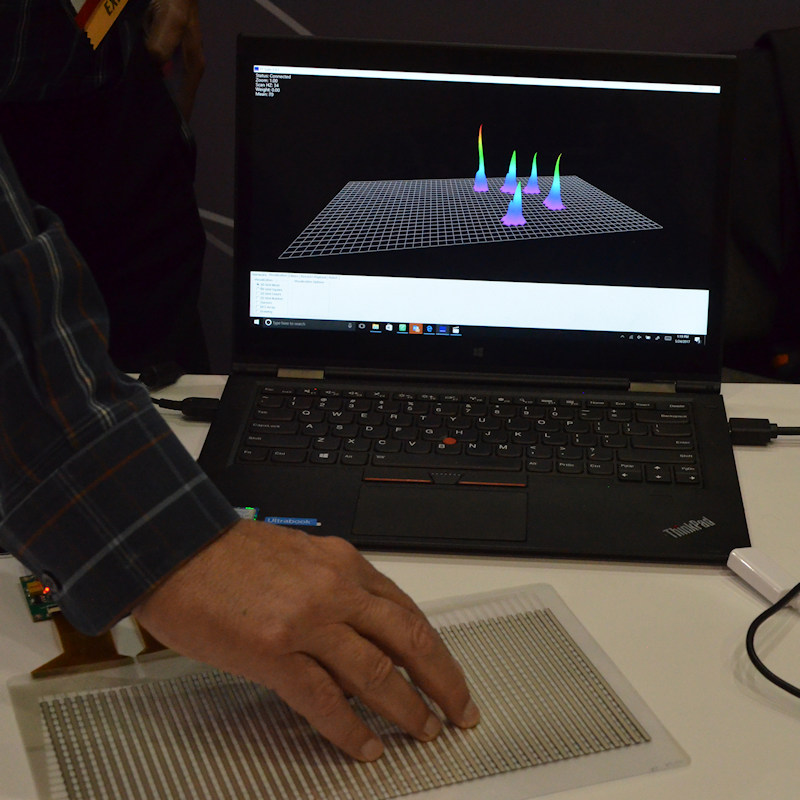 Force Touch demo by Richard McConnell Image:Ken Werner
Force Touch demo by Richard McConnell Image:Ken Werner
Peratech was one of several I-Zone exhibitors showing force-sensitive touch panels.
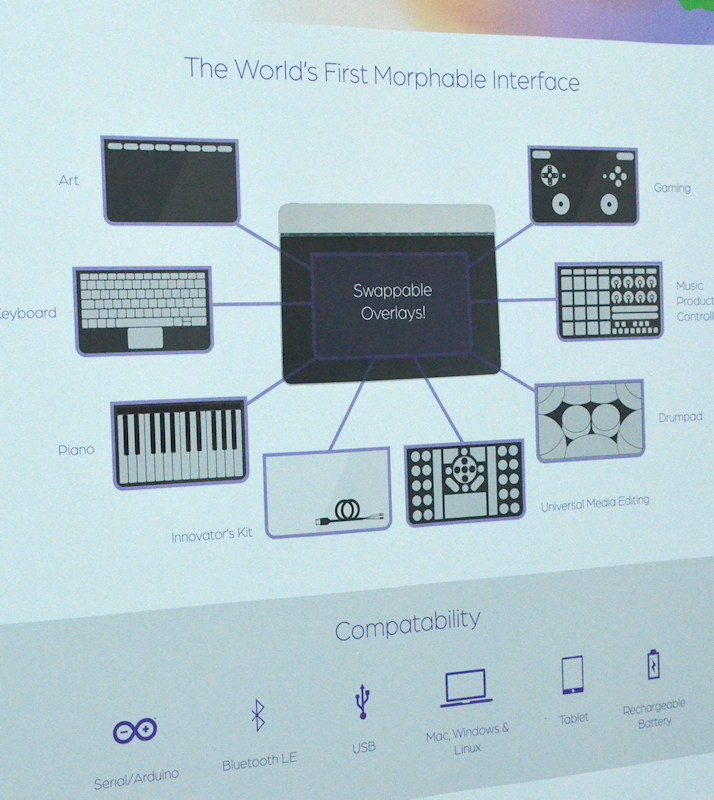
Sensel was another, but it added a wrinkle with The Sensel Morph, in which different overlays (such as an abbreviated piano keyboard) could be placed over the sensor for different applications.
The South China Academy of Advanced Optoelectronics of South China Normal University showed a three-layer color subtractive display using an electro-fluidic approach similar to that developed by LiquaVista. They have constructed a Gen 2.5 manufacturing facility and are focusing on relative large pixels for outdoor displays. I don’t know the folks at South China Normal have thought about the IP ramifications of their work. LiquaVista was absorbed into Amazon, and little has been heard about them recently. Perhaps Amazon has lost interest. Perhaps not.
Ngomad was showing an aftermarket anti-reflection film which uses a slow-sputtered TiO2. The company said the film reduces reflectivity from 4.5% to 0.7% and is available now.
Exalos was showing its red, green, and blue Superluminescent Light Emitting Diode (SLED) modules. According to Christian Velez, SLEDs have a beam focus that is nearly as good as a semiconductor laser’s but with markedly less speckle, and that seemed to be supported by the booth demo. (These are shipping products so they should not have appeared in the I-Zone. The Display Week organizers would have been delighted to rent them a booth on the main show floor.)
And let’s not forget PixelDisplay, which was showing a light source for backlights. Please see our Display Daily (PixelDisplay: Old Wine in a New Bottle).
There were other exhibitors at I-Zone that are worthy of mention, as well as many that are not. The I-Zone has certainly not lost its luster, but the selection committee would do the event a great service by intensifying its focus. — Ken Werner

